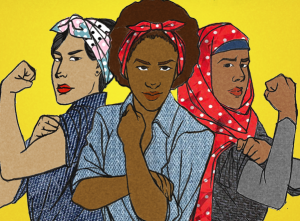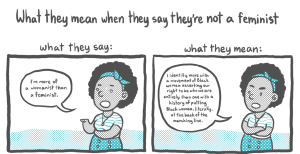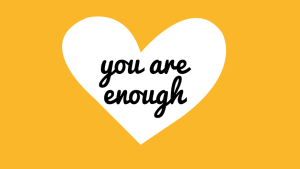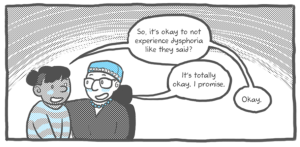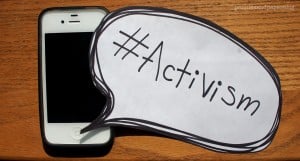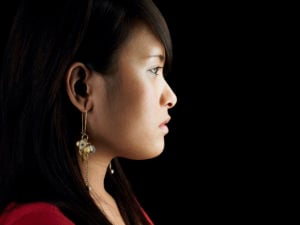If you’re a woman living in the United States, chances are you’ve heard something along the lines of this:
(Cut to black and white dialogue)
“My ex-girlfriend was the worst. She was always asking me to be, like, present for her emotionally. What does that even mean? Women are crazy sometimes.”
“I know what you mean, dude. I have two sisters and they cry all the time. I say one thing to them and they get all hysterical on me. They accuse me of being ‘insensitive’ or whatever.”
“It’s because girls are just more emotional than dudes. They get real mentally unstable when it’s that time of the month…if you know what I mean..”
*“Casual cissexism (Not all women have periods.)” flashes across the screen*
Unfortunately, the intersection of mental health stigma and sexism is all too common in our culture. Women are often depicted as “crazy,” emotionally unstable, overly sensitive, or hysterical. This is what I like to refer to as the Hysterical Woman stereotype. Not only is this stereotype used to devalue and disregard women’s thoughts, feelings, and opinions, but it also paints mental illness in a negative light.
On one hand, the Hysterical Woman stereotype demonizes women who express their emotions. On the other hand, it portrays mental illness as a defect that can be used to write off mentally ill people altogether. This stereotype functions to categorize both women and mentally ill people as abnormal, weak, incompetent, and inferior to social majority groups, such as men and non-mentally ill people.
Some of you might be wondering how this stereotype came about in the first place. Well, the construction of femininity and the construction of mental illness are actually pretty similar.
Historically, mental illness has been constructed as a mental defect or as a lack of ability to function in mainstream society. If non-mentally ill people set the standard for how “normal people” should function in everyday life, then mentally ill people, by definition, are perceived as dysfunctional – and not the norm.
Social views about mental illness, like disability, are rarely articulated explicitly, yet they still remain deeply ingrained in our cultural consciousness. Mentally ill people are stereotyped as emotionally unstable, untrustworthy, incompetent, lazy, weak, dependent, and even dangerous. Not only does this stigmatization of mental illness create prejudice against mentally ill people, but it makes mentally ill people more likely to be discriminated against in larger social institution, like schools, housing, and the workforce.
*flash institutions on screen*
It’s also extremely ironic that we label the mentally ill as dangerous and violent, because on top of discrimination, mental health stigma puts mentally ill people at a higher risk of abuse and sexual assault. This violence directed toward mentally ill people can be perpetuated by individuals, but it also can stem from government run institutions, such as mental hospitals and the criminal justice system.
In her incredibly important piece on disability theory, Emory University professor Rosemarie Garland-Thomson coined the idea of the ability/disability system. *(cite on screen and in description, “Integrating Disability, Transforming Feminist Theory”) According to Garland-Thomson, the ability/disability system is “a pervasive cultural system that stigmatizes certain kinds of bodily variations.” This system can also be applied to mental illness and other mental variations like autism, or what some people describe as neurodiversity.
Neurodivergent, a term coined in the late 90’s, is used to describe people whose minds function differently than what societal standards consider “normal.” Activists who use the neurodiversity paradigm argue that “neurodiversity is a natural and valuable form of human diversity” (*quote on screen*) and the inequality that neurodiverse people experience is a result of social power dynamics rather than innate biological inadequacy.
The neurodiversity paradigm and the ability/disability system are really helpful when looking at mental health stigma because they attribute the discrimination that mentally ill people experience to cultural factors, rather than demonizing mental illness.
But what about the construction of femininity in relation to mental health stigma? According to Rosemarie Garland-Thomson, feminist disability theory illustrates that disability and womanhood are not natural states of inferiority, but culturally fabricated myths, similar to the social construction of race. Women have historically been stereotyped as dependent, frail, incompetent, unintelligent, and submissive. Like mental illness, the state of womanhood is similarly conflated with being flawed or inadequate.
According to Simone de Beauvoir’s The Second Sex, men are constructed as the default gender, whereas women are constructed in relation to them and almost always as inferior. De Beauvoir argues that masculinity represents both the positive and the neutral, whereas femininity represents only the negative. Damn.
Additionally, feminine perceived behavior is also stigmatized. For instance, women are frequently stereotyped as being too emotional or hypersensitive. According to a 2014 study (“Gendered Mental Disorders” by Boysen, et al-cite on screen), women are more likely than men to be characterized as expressing negative or inappropriate emotions in response to external stressors.
I don’t know about you, but I’ve seen some of my brothers’ responses to situations and I would argue that punching a hole in your door is… less than appropriate. This study states, “People perceive women, relative to men, as experiencing more distress, embarrassment, fear, guilt, sadness, shame, and shyness.” On the other hand, men are considered to be more rational, logical, and in control of situations.
Aside from being linked to a hierarchy of superiority and inferiority, gendered ideologies surrounding femininity specifically rely on negative cultural stigmas surrounding mental health. Women, regardless of mental health status, are often labeled as crazy or hysterical simply for expressing their emotions. Overall, women receive more mental health-related diagnoses than men, and these diagnoses often use gendered criteria that may disproportionately target women.
This hierarchy of gendered behaviors pathologizes feminine coded reactions to external stimuli as symptoms of mental illness, whereas masculine coded reactions are set as the default for mentally healthy behavior. Therefore, feminine coded behavior is not only linked to a hierarchy of masculinity and femininity that devalues women, but is also attached to a completely separate hierarchy of ability and disability that devalues the mentally ill.
So next time you think about calling your ex-girlfriend “crazy,” you should reconsider – because calling one woman “crazy” really only ends up hurting all other women and mentally ill people and makes it easier to discriminate against them.






